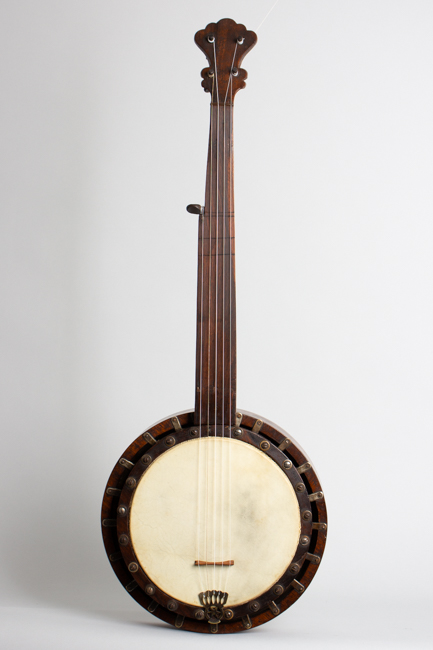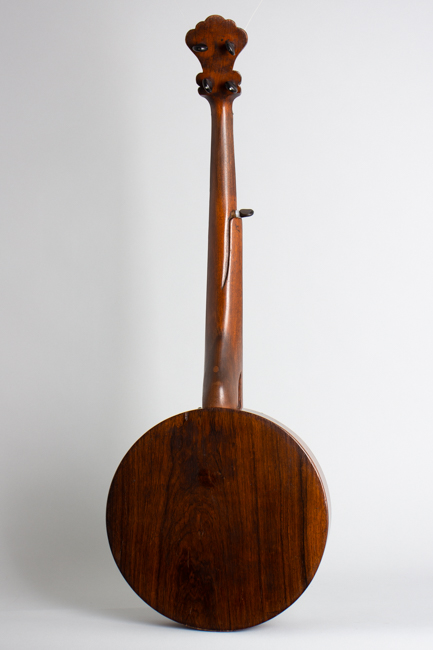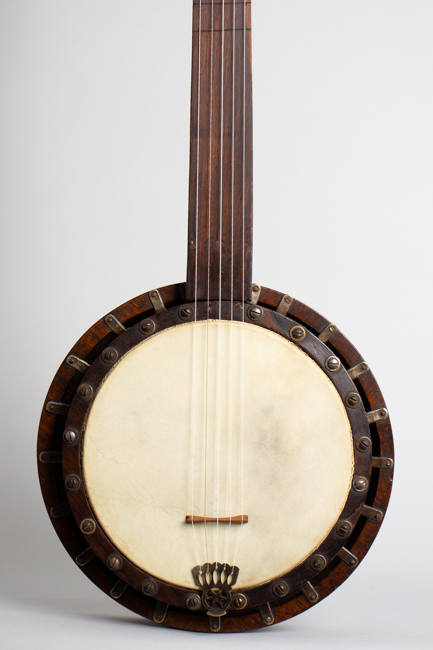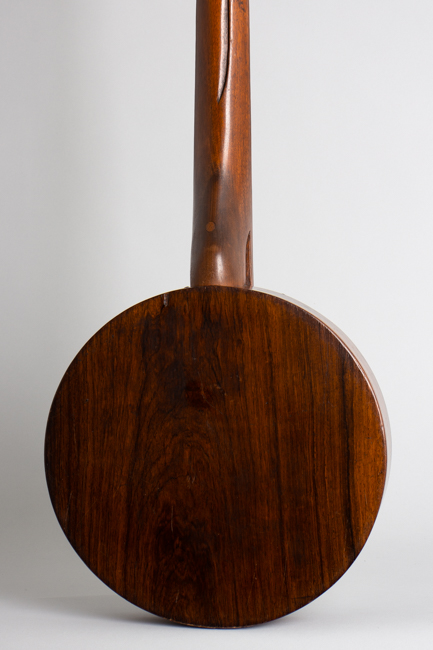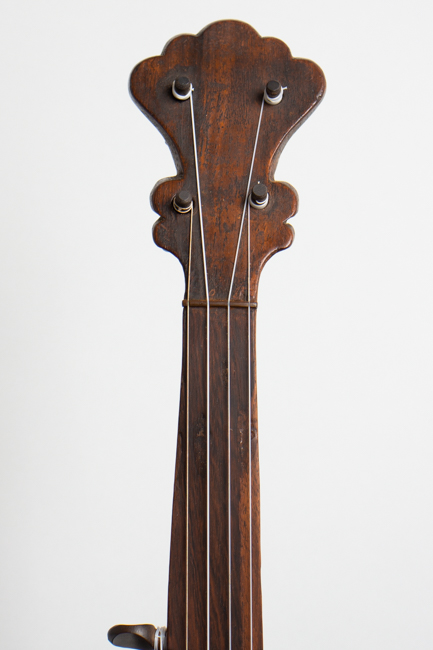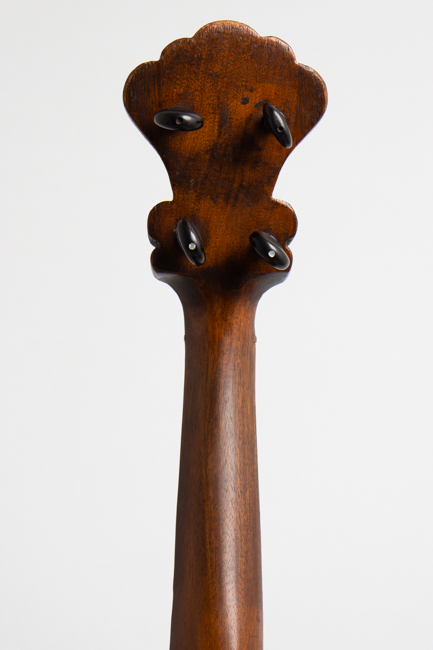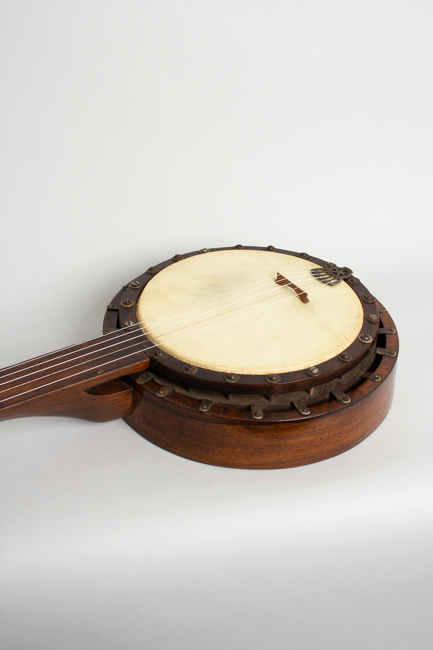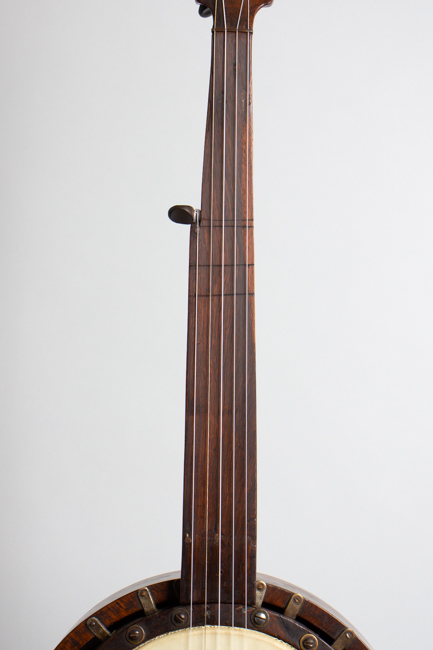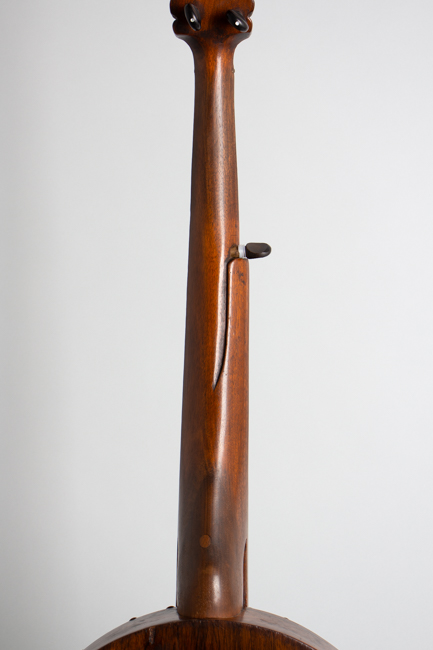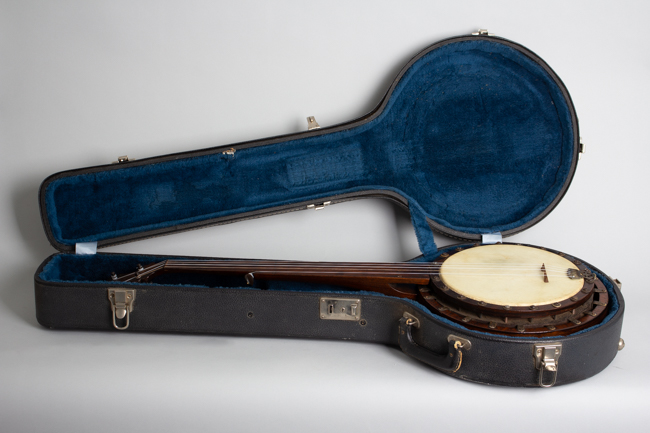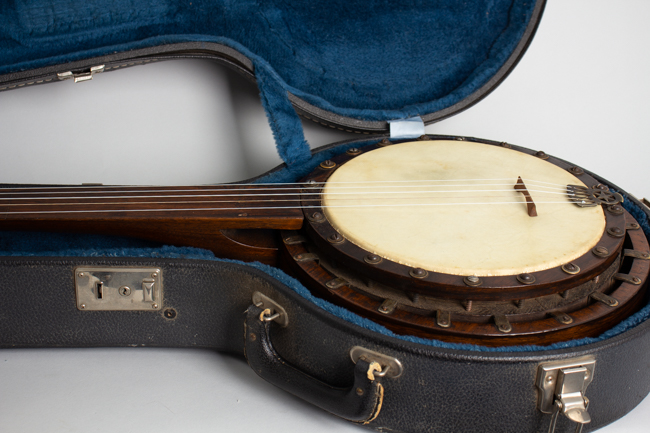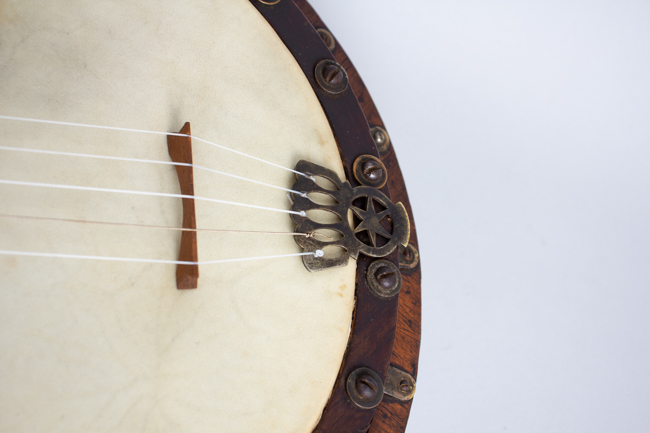Unlabeled 5 String Fretless Banjo, attributed to Henry C. Dobson , c. 1870
This item is currently on hold.
Item # 11668
Prices subject to change without notice.
Unlabeled Model 5 String Fretless Banjo, attributed to Henry C. Dobson, c. 1870, made in New York City, natural varnish finish, laminated rim and resonator with rosewood veneer; mahogany neck with rosewood fingerboard, black hard shell case.
This banjo is a fantastic piece of history, a playable survivor of the just-post Civil War era built right here in New York. While it carries no maker's marks, it is absolutely a Dobson style instrument unique to its time, similar to an example at the Smithsonian dated to 1877. When this instrument was built, banjo evolution had progressed only in fits and starts beyond the tacked-head Minstrel banjos of the 1840's and 50's. Compared to those, this is an incredibly futuristic banjo with some features that would not become common until the 1920s.
Unlike the common open back 19th century banjos this is a resonated, top tension instrument. The overall design is not unlike a 1920's Vegavox: the rim is fitted into a closed-back resonator and 20 screws are used to tension a wooden hoop from the top. The New York banjo world was rife with innovation in this period, and "inspiration" was sometimes taken despite nominal patent protection. Setting the rim into a resonator from above was pioneered by New Yorker George Teed, who was issued a patent in 1862. With further refinements by Brooklyn native Alfred Cammeyer the internal rim/resonator design became the basis for the English Zither banjo later in the 19th century.
Henry C. Dobson was the oldest of five Dobson brothers involved in the banjo trade in the 1860-1890s, starting as a teacher and progressing to designer and builder as was often the case. This instrument conforms most closely to his patent of 1867; the design continued to be developed over the next decade. The resonator is laminated with figured rosewood with the wooden rim and hoop set in via bent metal pieces screwed to the upper edge; the wood hoop has a laminated top surface as well. The mahogany neck is carved very shallow with a thin rosewood fretless fingerboard. The elaborate headstock with violin style pegs is typical of Dobson practice. This Dobson design disappeared in the later 19th century as Stewart and then Fairbanks & Cole perfected their "elevated" openback banjos that remain the standard today but this one survives as a fabulous link back to the wild and wooly banjo world of the 1870s.
Overall length is 35 1/2 in. (90.2 cm.), 9 3/4 in. (24.8 cm.) diameter head, and 3 3/4 in. (9.5 cm.) in depth, measured at side of rim. Scale length is 25 1/2 in. (648 mm.). Width of nut is 1 1/4 in. (32 mm.).
While it shows many signs of age, for being in the area of 150 years old this is a well-preserved instrument with a definite original patina. The very thin varnish finish is original with heavy checking and scratching on the back and numerous dings, dents and scrapes overall. The finish on the neck is worn down to the wood in several areas. There are some chips to the veneer on the wooden hoop, which has some surface cracks on the side just below the fingerboard but it remains solid.
The fingerboard has been trued in the lower areas to aid playability; above the "5th fret" area someone a century of more ago carved several lines to aid in position playing. There appear to be a few small filled holes in the fingerboard above the rim, the reason lost to history. There is also a larger neatly filled hole in the heel, purpose unknown. The back edge has one noticeable chip.
The hardware is nearly all older, much of it original. Several of the top-tension screws are replaced, and the screw holding the tailpiece is recent. The tailpiece itself appears original, matching the patina on other metal components. The wooden violin-style tuning pegs are period-correct if perhaps not exactly original and function well; the bridge has considerable age as well. The skin head is quite old; it is a bit overstretched but completely solid. This banjo plays well and sounds good with NylGut strings, a true trip back to 19th century New York. While we can't exactly recommend taking it out to entertain the rowdy crowd in an 1870's style saloon, this is a fully playable banjo for the dedicated historical player as well as a superb piece of New York banjo history. Overall Very Good + Condition.
This banjo is a fantastic piece of history, a playable survivor of the just-post Civil War era built right here in New York. While it carries no maker's marks, it is absolutely a Dobson style instrument unique to its time, similar to an example at the Smithsonian dated to 1877. When this instrument was built, banjo evolution had progressed only in fits and starts beyond the tacked-head Minstrel banjos of the 1840's and 50's. Compared to those, this is an incredibly futuristic banjo with some features that would not become common until the 1920s.
Unlike the common open back 19th century banjos this is a resonated, top tension instrument. The overall design is not unlike a 1920's Vegavox: the rim is fitted into a closed-back resonator and 20 screws are used to tension a wooden hoop from the top. The New York banjo world was rife with innovation in this period, and "inspiration" was sometimes taken despite nominal patent protection. Setting the rim into a resonator from above was pioneered by New Yorker George Teed, who was issued a patent in 1862. With further refinements by Brooklyn native Alfred Cammeyer the internal rim/resonator design became the basis for the English Zither banjo later in the 19th century.
Henry C. Dobson was the oldest of five Dobson brothers involved in the banjo trade in the 1860-1890s, starting as a teacher and progressing to designer and builder as was often the case. This instrument conforms most closely to his patent of 1867; the design continued to be developed over the next decade. The resonator is laminated with figured rosewood with the wooden rim and hoop set in via bent metal pieces screwed to the upper edge; the wood hoop has a laminated top surface as well. The mahogany neck is carved very shallow with a thin rosewood fretless fingerboard. The elaborate headstock with violin style pegs is typical of Dobson practice. This Dobson design disappeared in the later 19th century as Stewart and then Fairbanks & Cole perfected their "elevated" openback banjos that remain the standard today but this one survives as a fabulous link back to the wild and wooly banjo world of the 1870s.
Overall length is 35 1/2 in. (90.2 cm.), 9 3/4 in. (24.8 cm.) diameter head, and 3 3/4 in. (9.5 cm.) in depth, measured at side of rim. Scale length is 25 1/2 in. (648 mm.). Width of nut is 1 1/4 in. (32 mm.).
While it shows many signs of age, for being in the area of 150 years old this is a well-preserved instrument with a definite original patina. The very thin varnish finish is original with heavy checking and scratching on the back and numerous dings, dents and scrapes overall. The finish on the neck is worn down to the wood in several areas. There are some chips to the veneer on the wooden hoop, which has some surface cracks on the side just below the fingerboard but it remains solid.
The fingerboard has been trued in the lower areas to aid playability; above the "5th fret" area someone a century of more ago carved several lines to aid in position playing. There appear to be a few small filled holes in the fingerboard above the rim, the reason lost to history. There is also a larger neatly filled hole in the heel, purpose unknown. The back edge has one noticeable chip.
The hardware is nearly all older, much of it original. Several of the top-tension screws are replaced, and the screw holding the tailpiece is recent. The tailpiece itself appears original, matching the patina on other metal components. The wooden violin-style tuning pegs are period-correct if perhaps not exactly original and function well; the bridge has considerable age as well. The skin head is quite old; it is a bit overstretched but completely solid. This banjo plays well and sounds good with NylGut strings, a true trip back to 19th century New York. While we can't exactly recommend taking it out to entertain the rowdy crowd in an 1870's style saloon, this is a fully playable banjo for the dedicated historical player as well as a superb piece of New York banjo history. Overall Very Good + Condition.
